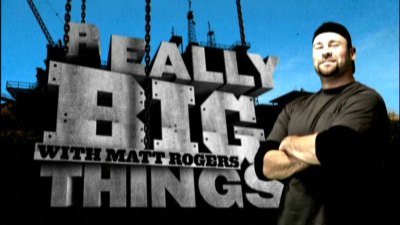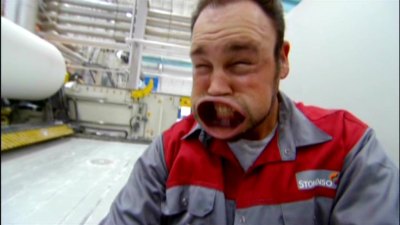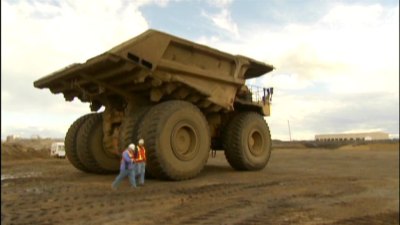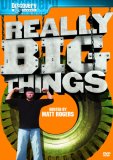| Reviews & Columns |
|
Reviews DVD TV on DVD Blu-ray 4K UHD International DVDs In Theaters Reviews by Studio Video Games Features Collector Series DVDs Easter Egg Database Interviews DVD Talk Radio Feature Articles Columns Anime Talk DVD Savant Horror DVDs The M.O.D. Squad Art House HD Talk Silent DVD
|
DVD Talk Forum |
|
|
| Resources |
|
DVD Price Search Customer Service #'s RCE Info Links |
|
Columns
|
|
|
Really Big Things
I've never had a chance to catch The Discovery Channel's Really Big Things on TV, the documentary series where a big lug of a goon goes around the world, messing with the biggest machines, working vehicles and tools out there. Having now watched the DVD release of Really Big Things, where six episodes of the series hosted by the genial giant Matt Rogers are included, I was immediately hooked. There isn't anything about Really Big Things that particularly distinguishes it from other similar shows on cable today, but the fact that this series takes as its speciality the concept of "bigness" - that largely despised doctrine in today's "less is more" society - immediately attracted me. Screw low-impact, low-profile, "green" micro-anything; Really Big Things celebrates the grotesquely large and powerful. And I love that.

The premise of the series is simple. Matt Rogers lummoxes his way to various corners of the globe, seeking out the biggest machines he can find, and then messes with the people operating them in the hopes of getting a chance to work them himself. In this particular collection, he visits, among other places, Sweden's largest paper-making plant, the biggest flight simulator in the world, one of the largest swing bridges in the world, a huge garbage compactor, and so on. Taken just at a kids' level, watching Really Big Things brings out the adolescent in any guy who grew up playing with his Tonka trucks (the real ones made out of metal that could kill you if your brother creased you over the head with one - not the girly ones they make now out of plastic). These are big toys, and it's tough not to get jacked up, thinking about driving the largest dump truck in the world. Growing up, I loved shows like Mr. Rogers' Neighborhood, Hot Dog, and What Will They Think of Next, because they always ran films that showed exactly how things were made (an attraction that still holds for many viewers today, as evidenced by series like Really Big Things and How It's Made on cable). Seeing a product going from raw materials to finished product is an endlessly fascinating process, and one I never get tired of watching.
But deeper than that, what attracts me to a show like Really Big Things is the celebration of man and his awesome ability to build, to create, to conquer the material world and shape it, engineer it, and structure it to his needs (uh oh; here come the emails). Of course, in today's dying-on-the-vine P.C. world, such sentiments are verboten and considered big, bullying hate speech directed at an innocent, dying world (calling Mr. Internet Inventor). Well, Bronx cheers to that. Really Big Things shows the absolute beauty and genius that humans bring to solving seemingly insurmountable technical problems (by the way, you'll be surprised at how many kick-ass women are tearing up on those macho monster machines -- check out the Swedish babe Anna who's an expert in dynamite mining). When I was a kid, Edison was considered a hero (I was lucky to grow up during the Bicentennial - the last time American kids as a whole were actively encouraged in school to be proud of their heritage), and Really Big Things, just by showing these amazing technical marvels, illustrates that "can do" spirit that is somehow considered so shameful today by a large segment of the public.
I also like Really Big Things' emphasis on the pure, physical joy in work. Definitely one of the big pluses of the show is host Rogers' interactions with the various workers who guide these massively complicated contraptions, and what always comes through is their modestly held pride in mastering a damned tough job. These women and men are humping it out there in the field or in the high-tech factory every day, providing us with all the materials and goods we routinely take for granted, and it's obvious - maybe just for a moment at least - that when Rogers comes in and goofs around with them on camera, they're happy somebody is noticing what they do. And it's important work, too, providing the paper, metals, oil, transportation, science (a huge telescope), and energy (huge windmills, dams) that we simply cannot live without, and that some people naively like to think should come cleanly out of the thin air or spring forth fully born from the head of Zeus.
Even when the contraptions shown have no real gut-level importance to our lives (such as a massive events stadium in Arizona or a huge Las Vegas theatrical show), the true beauty lies in the fact that we can and do think up such things - and then execute them. The main motif behind Really Big Things is that "big equals better." Big equal more money. Big equals more efficiency, which equals more production, which equals more money (and to all you tree-huggers out there, it also means less impact on the environment - check out the huge windmill farms here or the low-impact mining). And the individual episodes spend plenty of time showing us the entire process - something that other cable shows like Really Big Things sometimes skimp on. As for the host, Matt Rogers, he reminds me of those former high school athletes who could go psycho on you in a second after one too many beers. He's not exactly the most charismatic guy, but I do enjoy his patently bumbling, loud-mouthed "big American kid" manner with the foreign workers, whose reactions range anywhere from delight to perplexity to downright hostility (check out the one worker in the Swedish paper plant who keeps "accidentally" hitting Matt with a big pole). If Really Big Things is going to celebrate the best of the "big," why not have a host who's a gigantic (but endearing) pain in the ass?

Paper Maker
Matt introduces us to the mammoth Concrete Mat Sinking Unit that lines the bed of the Mississippi River to help stop erosion, and then he's off to an enormous copper mine in Sweden to witness the earth-shaking "Rammer Hammer" break down huge pieces of ore. Finally, Matt helps a team of workers operate the world's largest paper-making machine, capable of churning out a million tons of paper a year.
Windmill Factory
When it's game time at the Arizona Cardinals' stadium, the 12-million-pound football field is rolled on a gigantic tray from outside to inside the arena. And in Alberta, Canada, Matt goes for a ride in the world's biggest dump truck, which weighs more than a million pounds and has tires over 14 feet tall! Then Matt is off to a factory in Germany to help assemble massive 85-ton windmills.
Largest Telescope
Living a childhood dream, Matt takes a test flight on NASA's hulking Vertical Motion Simulator in Silicon Valley, California, simulating the flight of the space shuttle. Then, deep underground in a mine near the Arctic Circle, he lends a hand in drilling explosive blast holes using the powerful Blast Hole Drill. And in southern Arizona, Matt joins a group of astronomers to operate the world's largest binocular telescope, housed in an 18-story building.
Giant Tree Spade
In a small North Carolina town, a family-owned business performs a really big job - retreading the giant tires from enormous machines all over the world. Then Matt travels to Washington state where he visits the Grand Coulee Dam, the largest concrete structure and the largest producer of hydroelectric power in the United States. And when it comes to gardening equipment, the Giant Tree Spader is a whopper - nearly 100,000 pounds and 70-feet long, it can safely uproot full-grown trees in one scoop of its eight oversized blades.
Swing Bridge
In Erie, Pennsylvania, Matt joins the crew building the latest technological marvel in transportation - the huge Evolution Locomotive, the cleanest diesel-powered train ever built. Then he goes aborad the massive Dredge Jadwin to see how the Army Corps of Engineers keeps the Mississippi River clear for boat traffic. And Matt shows a different aspect of river navigation in Seattle, Washington, home to the Southwest Spokane Street Swing Bridge, one of the heaviest moveable bridges in the world.
Really, Really Big Show
Matt joins the crew of the "Spirit of America" Goodyear Blimp in Carson, California, where he helps to get this jumbo airship aloft. Then he travels to Bakersfield, California, where a truly monstrous machine can be found working at one of the smelliest and dirtiest jobs - compacting 2,000 tons of garbage a day. And finally, it's back into the air with the high-flying acrobats and performers of the spectacular Las Vegas Cirque du Soleil stage show, where he goes behind the scenes to uncover the secrets of the incredible stage mechanism that powers the jaw-dropping theatrical extravaganza.

The DVD:
The Video:
The anamorphically enhanced, 1.78:1 widescreen image for Really Big Things is clear and sharp, with bright colors and no transfer issues.
The Audio:
The Dolby Digital English 2.0 stereo audio mix is adequate for the job here, although unspectacular (too bad there wasn't a 5.1 mix for some of those huge mining operations). There were no close-captioning or subtitle options.
The Extras:
There are no extras for Really Big Things.
Final Thoughts:
Every red-blooded American knows bigger is better - and apparently, so does the rest of the world, too, as Matt Rogers travels around the globe, highlighting the biggest, nastiest, most powerful machines, tools and vehicles out there. It's a real tribute to the art of man, and his ability to shape and structure the material world to his needs - even in the service of being "green," if you absolutely must. I had a good time watching Really Big Things, and I'll be looking forward to more episodes. I recommend Really Big Things.
Paul Mavis is an internationally published film and television historian, a member of the Online Film Critics Society, and the author of The Espionage Filmography.


|
| Popular Reviews |
| Sponsored Links |
|
|
| Sponsored Links |
|
|
| Release List | Reviews | Shop | Newsletter | Forum | DVD Giveaways | Blu-Ray | Advertise |
|
Copyright 2024 DVDTalk.com All Rights Reserved. Legal Info, Privacy Policy, Terms of Use,
Manage Preferences,
Your Privacy Choices | |||||||













